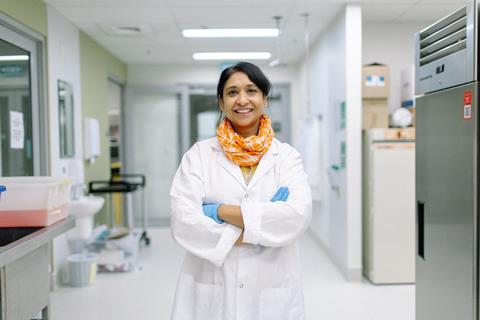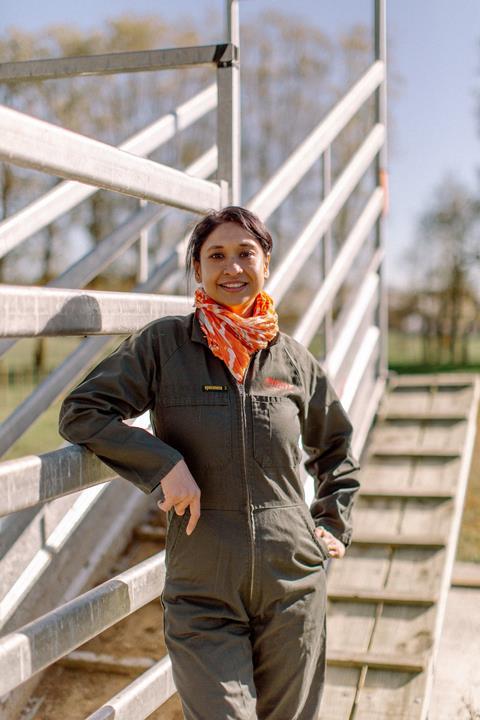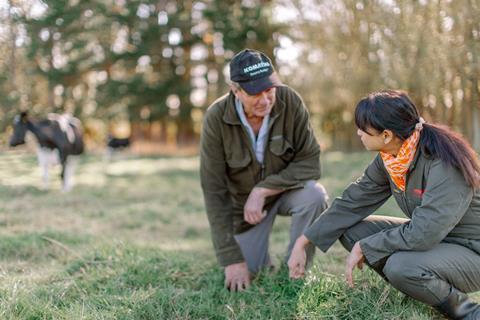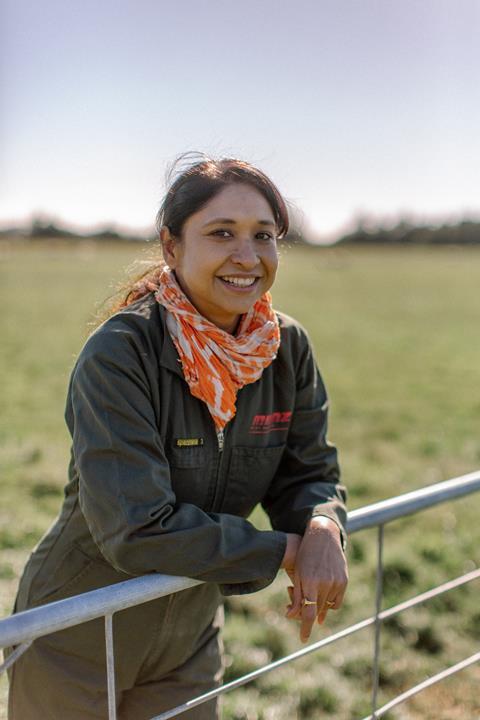AMI Global Ambassador for New Zealand Tanushree Gupta is bringing an antifungal product to market that will make a huge difference to the hundreds of farms affected by facial eczema - so here’s how it’s going.
Farmers across New Zealand are battling a fungal menace that is costing the livestock sector an estimated $332 million a year. But Tanushree has the answer - and earlier this summer she pitched her solution to a group of potential investors who could help her to launch a treatment for facial eczema.

Facial eczema is caused by a toxin-producing fungus and affects the health of sheep, cattle, deer, goat and alpacas.
The economic impact to farmers is estimated at $332 million annually through losses caused by reduced animal growth rates, fertility and production. It can also cause significant stock losses during severe outbreaks. Not only that, but the disease is forecast to spread more widely across the country as climate change bites.
Side effects
There’s no cure, and zinc dosing is one of the few management tools available, but overdosing can be toxic to animals and cause a host of side effects - so Tanu’s discovery could be a godsend to the livestock sector. She has found promising antifungal molecules in both bacteria and fungi, but in this case the active ingredient comes from a bacterium.
One of AMI’s newest Global Ambassadors, Tanu was awarded the Basil Jarvis Prize in 2022 for her contribution to food safety and security.
She works in the space of dairy and meat microbiology, determining sources of pathogens and spoilage bacteria that reside in farms and can enter the food chain causing quality and safety issues. She is also exploring novel and natural ways for compounds to enhance the shelf life and safety of food in the food chain.
Bold step sideways
As an AgResearch senior scientist in the Food System Integrity Team based at the Hopkirk Research Institute in New Zealand, Tanu has been a researcher throughout her entire career - but this summer’s pitch session marked the culmination of a bold step sideways into the realm of commercialisation.
It was her research with anaerobic bacteria that led her to a solution for the facial eczema problem, as she explains.

“I’m a microbiologist, looking at dairy microbiology, food microbiology, and dealing with the safety and the risk assessment of our food and food chain. So we were looking at some natural bacterial metabolites that are being specifically produced by anaerobic bacteria - that’s where my focus is, and how we can utilise those metabolites as antimicrobial substances,” she explains.
“So looking at the use of those antimicrobials, I started working with facial eczema around maybe four years ago as part of the Curiosity Fund.
Combination of natural compounds
“We wanted to investigate the combination of some of those natural compounds against the fungus that causes facial eczema - and we saw some really amazing results. Those metabolites were actually reducing the growth, or stopping the germination of the spores of fungus.
“So from there on, that journey started, how we could look more deeply into it, how we could work ahead to maybe have a product with those metabolites as active ingredients, and work on reducing these incidences on the farm.”
At the start of her career, after studying to be a microbial and food technologist, Tanu joined the National Dairy Research Institute in India as a research fellow, where she trained in molecular biology working on producing rennet enzymes through recombinant technology which can be utilised by dairy companies to make cheese rather than using rennin from calves’ stomach.

She did a PhD at Delhi University, India, on antibiotic resistance in nosocomial pathogens from hospital settings, giving her the opportunity to connect with doctors and pathologists in different hospitals.
Post doc research
After moving to New Zealand Tanu joined AgResearch as a Post Doc, where she worked on a diverse range of projects such as investigating biofilm formation by the pathogen Cronobacter sakazakii, and the genes responsible for enabling E. coli O157:H7 to survive under stress and extreme environments.
As a senior scientist Tanu has been working in a diverse range of projects including intervention to reduce microbial contamination in the food chain and exploring novel and natural compounds to enhance the shelf life and safety of food. One such example is identifying natural bacterial metabolites that can be used as food preservatives or antimicrobials and how to commercialise these. Tanu is also working with CRISPR/Cas system to develop assays for enhanced detection of food borne pathogens in food.
Eye opener
Tanu says she enjoys her research work, but a couple of years ago she began to ponder doing something for the betterment of New Zealand and its people.

“We shouldn’t be just stopping there, we’re writing papers, submitting them in journals - but what else can we do outside? And I think for me, commercialisation was an eye opener - how we can develop our science in a way that we can get revenue out of it and have a real impact,” she says.
“When you see that someone is using your product, that gives you a different level of satisfaction, and that’s why I want to do something. In the longer run, have something out there so that I can see that there is a huge reduction in facial eczema incidences.”
Innovation course
Her adventure was sparked by a conversation with a member of AgResearch’s commercialisation team who suggested that Tanu apply for a place on the Kiwinet Emerging Innovation Course.
“I pitched my idea to the advisors who were on the panel in the Kiwinet Emerging Innovation Course, and they looked into what my idea is, what idea I have of the market, whether it’s a product, or a tool, or software, who are the competitors in the market that I should be working with, or I should enhance my product,” she says.

“I pitched the idea and was given that fund, and then started my journey by looking and understanding what the market is and whether there was the need for that product.
Listening is key
“One of the main things that I learned from the course around market analysis - going and talking to your peers, going and talking to your stakeholders, what their suggestion is, and listening to them very carefully - was that listening is really important, rather than just talking about your ideas.
“We get carried away - as scientists, we really encourage ourselves to think outside our box and we get too excited about our science. But at some point, you have to stop talking and start listening to others about their problems and their views about that particular idea. To take it forward, you need to listen to the demand of the market.
“It’s a process of different steps. You cannot just finish your project and then take it to the market and say, Oh, I have got this fantastic proof of concept, and I think it’s ready to be commercialised. You have to take that journey, because at the end of the day you need to generate the revenue so that you can keep doing the work. We need to understand who our next or immediate users and who the end users are. They are ones who will aid in taking the products to the market. In short, we need to have the right time to walk on the path of commercialisation.”
Potential investors
Tanu was the only New Zealander to secure an award in the Australasia-based AgriFutures growAG 2024 catalyst programme, after her work was recognised in the new research and product development section.That award process then secured her a place in front of potential investors for the antifungal product.

She is hoping that in a commercial form the product could be sprayed onto paddocks or even applied irrigation: “My main goal is to move away from having to treat the animal in response to the fungi’s presence.”
Tanu says the commercialisation gave her great support in aspects such as IP protection, but there have been parts of the journey that have been more challenging for her.
Talking to farmers
“It really gets difficult when you have to go out and do the actual science outside the lab - you have to go and talk to farmers, whether they are willing to give me the opportunity to test the compound, etc
“Because it’s not that simple as… you have a compound and just get sprayed and done. There are a lot of legal activities that you need to do. You have to go and talk to the regulatory bodies, get it regulated, and get acceptance approvals, whether that can be used even for testing purposes.
“So these are the things that push you a bit back, and that may happen with a lot of people - but trust me, it’s just a journey. Take it as a learning curve, and you will enjoy it.”
Open to collaboration
Tanu says that while the commercialisation drive is focused on animals, she would love to eventually extend her discoveries to human use. And she stresses that she is very much open to collaboration if anyone reading this would like to reach out.

Finally, she adds a few words of advice to anyone thinking of taking that journey: “Have that open mind, understand the need, understand the market - that is the most important step to start thinking about commercialisation. Don’t think about what’s next. Deal with it when it comes but think about your idea, and think about the need for that idea.”
Tanu’s tips for commercialisation
- One thing is common for all - to understand the market need. After that you get in touch with the commercialisation team and go with the demand.
- Conquering funding from commercial partners for doing lab work will be difficult, so we will still need to have that component, to secure other funding to complete the scientific work.
- If we want to commercialise our science, it’s very important to keep in mind that nothing should go to public domain or database. Once IP is secured then we can publish that work.
- There is more venture funding for startups, but not so much for an organisational commercial work. You need the right mentor who can help you go through the commercialisation path.
To find more about Tanu Gupta’s research and AgResearch, click HERE.
Topics
- AgResearch
- Agriculture
- Applied Microbiology International
- Asia & Oceania
- Bacteria
- Basil Jarvis Prize
- Be inspired
- Climate Action
- Commercialising the microbiome
- Community
- Delhi University
- Economic Equality
- facial eczema
- Food Security
- Fungi
- Healthy Land
- Horizon Awards
- Kiwinet Emerging Innovation Course
- One Health
- Pharmaceutical Microbiology
- Tanushree Gupta
- Veterinary Medicine & Zoonoses







No comments yet